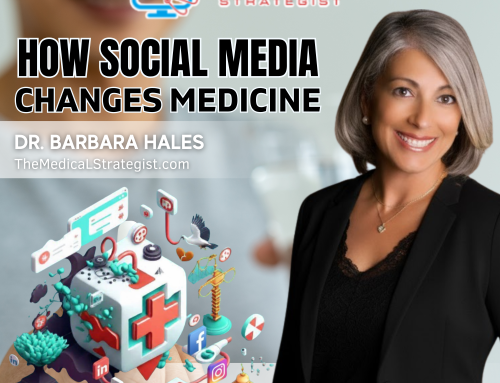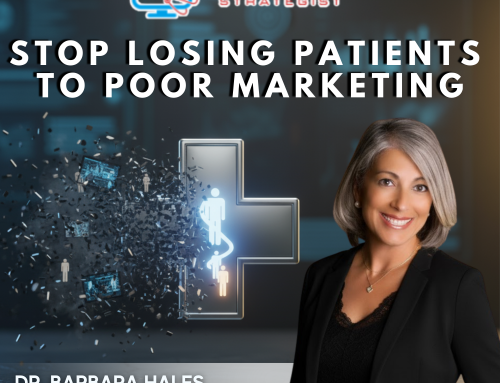Podcast: Play in new window | Download
Subscribe: RSS
In this episode, Dr. Barbara Hales and Viveka von Rosen discuss:
- The importance of optimizing LinkedIn profiles for patient engagement and networking.
- Strategies to create a patient-focused and professional LinkedIn presence.
- How to use video content and AI tools effectively for visibility on LinkedIn.
Key Takeaways:
“Always be audience-focused, and come from a place of being a resource, not a resume!” – Viveka von Rosen
Connect with Viveka von Rosen:
Website: https://vengreso.com
LinkedIn: https://www.linkedin.com/in/vivekavonrosen/
Twitter: https://twitter.com/LinkedInExpert
Facebook: https://www.facebook.com/VivekaVonRosen
YouTube: https://www.youtube.com/user/LinkedInExpert
Connect with Barbara Hales:
Twitter: @DrBarbaraHales
Facebook: facebook.com/theMedicalStrategist
Business website: www.TheMedicalStrategist.com
Show website: www.MarketingTipsForDoctors.com
Email: info@TheMedicalStrategist.com
YouTube: TheMedicalStrategist
LinkedIn: www.linkedin.com/in/barbarahales
Books:
Content Copy Made Easy
14 Tactics to Triple Sales
Power to the Patient: The Medical Strategist
TRANSCRIPTION (185)
Introduction
Dr. Barbara Hales: Welcome to another episode of Marketing Tips for Doctors. I’m your host, Dr. Barbara Hales. Today, we are very fortunate to have with us Viveka von Rosen. She has spent almost two decades helping businesses and individuals amplify their visibility, voice, and vision online. Having authored four bestselling books on LinkedIn, including LinkedIn Marketing an Hour a Day and 101 Ways to Rock Your Personal Brand, Viveka is still recognized as a leading LinkedIn expert.
Her expertise has been highlighted by top publications, including Forbes, Fast Company, Buzzfeed, Inc., CNN, and Entrepreneur. She is also a frequent contributor to Forbes and has produced five courses for the LinkedIn Learning platform. Now, having pivoted her career, Viveka is passionate about empowering executives in their 50s and beyond to transition from corporate life to entrepreneurship, helping them build legacy businesses that align with their values and vision. Welcome to the show.
Viveka von Rosen: Thank you so much. I appreciate being here. You know, I was doing a podcast like 20 minutes ago, and my guest said, “I don’t use the word pivot anymore. I use the word evolve.” And I like that because pivoting feels like staying in place, but evolving means going to the next level. So, I might need to change my bio to say I help businesspeople in their 50s and beyond evolve.
Dr. Barbara Hales: That sounds like next-century terminology.
Viveka von Rosen: Exactly. Forget pivoting; that’s so 2024.
Optimizing LinkedIn Profiles for Doctors
Dr. Barbara Hales: Tell us, how can doctors make their LinkedIn profiles more appealing to patients and colleagues?
Viveka von Rosen: Good question. Many medical professionals overlook their LinkedIn profiles because they don’t think it’s important. However, when people search for your name online, your LinkedIn profile is often one of the first results. If your profile isn’t well-branded or up-to-date, it can hurt your professional image. Here’s how to improve it:
- Visual Branding: Align your LinkedIn header image with your website branding. Make sure your profile photo is recent and professional.
- Headline Optimization: Use the headline section under your name to highlight your expertise and who you help. For example, instead of just listing your title, describe your specialty and patient focus.
- Featured Section: Use this section to showcase interviews, articles, or other resources that highlight your expertise.
- About Section: Write this in the first person, focusing on who you help and how. Avoid making it a resume. Speak directly to your audience and tell stories that connect with them.
Building Strategic Partnerships on LinkedIn
Dr. Barbara Hales: What about connecting with other doctors for referrals?
Viveka von Rosen: That’s a great point. Your LinkedIn profile isn’t just for patients; it’s also for building strategic partnerships. To connect with other professionals:
- Personalize your connection requests with a brief message.
- Use the mobile app to send voice or video messages after connecting.
- Focus on authenticity. A simple, “Hi, I noticed you specialize in XYZ, and I believe we could be great referral partners” works well.
Transitioning LinkedIn Profiles for New Roles
Dr. Barbara Hales: What steps can doctors take to transition their profiles for new roles like consulting or leadership?
Viveka von Rosen: Add a new experience section to reflect your new focus. This notifies your network about your evolution. You can also:
- Use LinkedIn posts to share updates about your transition.
- Highlight press releases or interviews in the featured section.
- Tailor your headline and about section to reflect your new goals.
The Value of Consistent Video Content on LinkedIn
Dr. Barbara Hales: Are consistent videos on LinkedIn valuable for medical professionals?
Viveka von Rosen: Absolutely! Videos, especially vertical ones, are gaining traction on LinkedIn. They help personalize your brand and connect with your audience. You can create videos on topics like medical procedures, pre-op instructions, or patient education. Upload them natively to LinkedIn for better visibility.
Tips for Quick LinkedIn Success
Dr. Barbara Hales: What are two tips you can give our listeners that they can implement right away to improve their LinkedIn presence?
Viveka von Rosen: Sure! First, always make your profile audience-focused, whether it’s for patients, strategic partners, or even new hires. Tailor your headline and about section accordingly, and update them as needed. Second, always focus on being a resource. Whether it’s a post, a newsletter, or a featured article, think about how it can serve your audience.
How Videos Can Build Engagement
Dr. Barbara Hales: For medical practices, videos can showcase techniques, machines, or instructions. How valuable is consistent video content for a LinkedIn page?
Viveka von Rosen: Very valuable! Vertical videos are trending on LinkedIn. These videos feel authentic and are more likely to get visibility. Whether you’re narrating a topic, showcasing equipment, or explaining techniques, videos give a sense of who you are and build trust with your audience.
Dr. Barbara Hales: And if someone doesn’t want to appear on camera?
Viveka von Rosen: They can still create value-based videos focusing on the topic or equipment while narrating off-camera. However, I recommend showing your face whenever possible—it helps build connection and trust.
Closing Remarks
Dr. Barbara Hales: This has been a fun and informative interview. Thank you so much for joining us today.
Viveka von Rosen: My pleasure. Thank you, Barbara.



